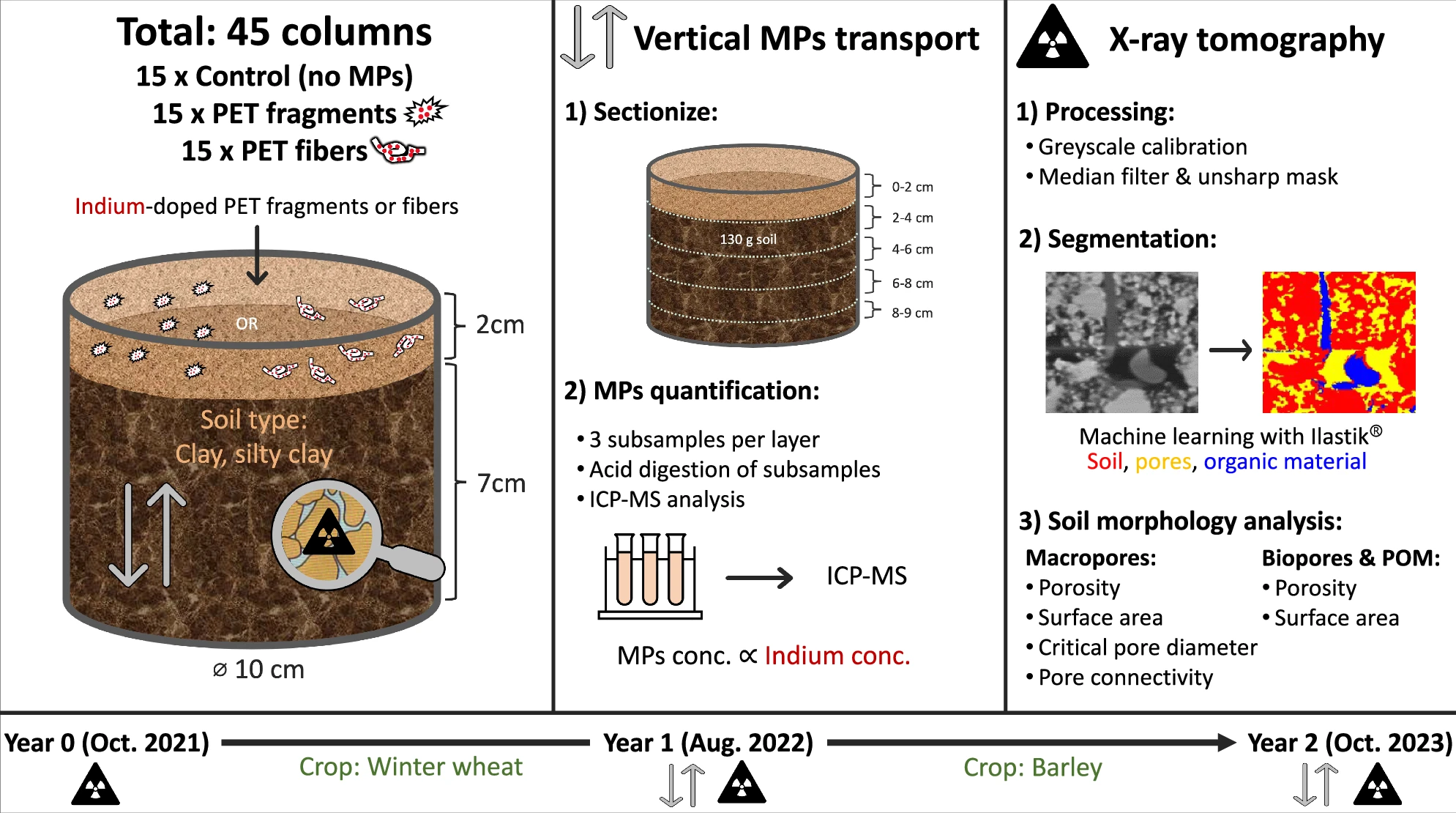Microplastics in Soil - Findings from a Two-Year Study
I recently came across a paper on X.com that caught my attention due to its relevance to my intended PhD research and my interest in microplastics. Titled “Minimal vertical transport of microplastics in soil over two years with little impact of plastics on soil macropore networks,” the study investigates how microplastics behave in soil over extended periods. After reading it, I wanted to share a summary of the methods, results, and implications, along with my thoughts on how this work could inform future research.
Experimental Design: Mimicking Real Agricultural Systems
The researchers conducted a two-year field experiment using 45 soil columns packed with clay-rich soil. These columns were embedded in an agricultural field in Switzerland to simulate real-world farming conditions. Three treatments were applied: control columns with no microplastics, columns with indium-doped polyethylene terephthalate (PET) fragments, and columns with PET fibers. The plastics were concentrated in the top 2 cm of soil, reflecting common entry pathways for microplastics, such as mulching films or sewage sludge.

To track plastic movement, the team used indium-doped PET. Indium, a rare metal, served as a tracer, allowing precise measurement of plastic migration through soil layers using inductively coupled plasma mass spectrometry (ICP-MS). X-ray tomography provided 3D images of soil structure, focusing on macropores, which are large pores critical for water infiltration, root growth, and gas exchange. The experiment spanned two crop cycles (winter wheat and barley), with soil structure and plastic transport analyzed annually.
Key Results: Limited Movement and Soil Adaptation
Plastic Transport Was Minimal
After two years, only about 1% of the microplastics reached depths below 8 cm. Most remained concentrated in the upper soil layers where they were initially applied. Fibers showed slightly higher mobility than fragments in some layers, but overall, both types moved very little. This contrasts with lab studies suggesting faster transport, highlighting how natural soil processes like compaction, root activity, and earthworm burrowing; limit vertical migration.
Soil Structure Remained Largely Unaffected
Despite initial concerns, microplastics had negligible long-term effects on soil macropores. While soils with plastics initially showed slightly higher macroporosity, these differences disappeared by the second year. Natural processes, such as plant root growth and bioturbation, appeared to override any short-term structural changes caused by plastics. Over time, macropore networks evolved independently of plastic presence, driven by biological activity and environmental factors like wet-dry cycles.
High Recovery Rates Highlight Method Reliability
Over 80% of the added microplastics were recoverable after two years. This suggests minimal degradation or lateral loss, underscoring the effectiveness of indium as a tracer. It also implies that microplastics may accumulate in topsoil over time, rather than dispersing or breaking down rapidly.
Implications for Agriculture and Policy
This study challenges assumptions about microplastics’ immediate threat to soil structure. By replicating real-world conditions, it provides evidence that soils can adapt to plastic presence, at least in the short term. However, the authors caution against extrapolating these results too broadly. The experiment used PET at 1% concentration (a level representing pollution hotspots) and did not assess chemical or microbial impacts. Polyethylene (PE), more commonly used in agriculture, might behave differently. Additionally, nanoplastics (smaller than 1 µm) were not studied but could pose greater mobility risks.
For policymakers, the findings suggest prioritizing plastic reduction in contamination hotspots, such as transitioning from conventional mulch films to biodegradable alternatives. For researchers, the study underscores the importance of long-term field experiments over short-term lab trials, which often overlook soil’s adaptive capacity.
Reflections for Future Research
This paper has shaped my approach to drafting a research proposal in three key ways:
- Long-Term Field Data Matters: Short-term studies risk overestimating plastic impacts. My proposal will emphasize multi-year experiments to capture soil’s dynamic response.
- Beyond Physical Structure: While macropores were unaffected, microplastics might alter microbial communities or nutrient cycling. Future work should integrate chemical and biological metrics.
- Tracer Methods as a Tool: The use of indium-doped plastics demonstrates a reliable method for tracking environmental fate. Similar approaches could be adapted for nanoplastics or other polymers.
Final Thoughts
This study offers a balanced perspective on microplastics in soil. While it does not dismiss risks, it highlights soil resilience and the need for nuanced, context-specific research. For early-career researchers like myself, it reinforces the value of patience in environmental science, because complex systems require time to reveal their secrets. As I refine my proposal and constantly approach professors with these ideas for my PhD, I’m inspired to explore unanswered questions: How do different plastic types interact with soil biota? Can biodegradable alternatives reduce long-term risks? And what happens when microplastics meet other stressors, like pesticides or climate extremes?
If anything, this paper is a reminder that environmental challenges demand both urgency and humility. Solutions will emerge not from alarmism, but from careful, iterative science.
References
- Commun. Earth Environ.Minimal vertical transport of microplastics in soil over two years with little impact of plastics on soil macropore networksCommunications Earth & Environment, Apr 2025
Enjoy Reading This Article?
Here are some more articles you might like to read next: